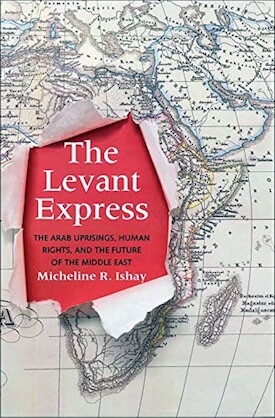Ishay, director of the international human rights program at the Josef Korbel School of International Studies, University of Denver, hopes to relaunch the human rights drive of the stalled Arab uprisings. She grounds her book in President Franklin Roosevelt’s 1941 Four Freedoms: freedom of speech and worship, and freedom from want and fear. The author divides the book into three parts: the human rights uprisings, the counter-revolutions, and the four rights in the age of counter-enlightenment.
For Ishay, technological and communications mechanisms are key. The Industrial Revolution inspired the invention of the railroad, which hastened the process of urbanization and facilitated the coming together of disenfranchised people as well as the transmission of revolutionary ideals. Ishay writes of a “revolutionary tradition” beginning with what she terms the “Trans-Europe Express” (1848), which contributed to the revolutions of 1848 on the continent and even to the Arab uprisings in 2011. She posits that the defeat of nineteenth-century revolutions did not doom the political transition of Western and Central Europe toward democracy and economic wellbeing. Nor did the Warsaw Pact crushing the Prague Spring in 1968 stop the 1989 anti-Soviet revolutions in Eastern Europe. Similarly, Ishay argues that defeat of the Arab uprisings should not stop Arabs from trying for reform, and here she introduces Roosevelt’s four freedoms as a means of promoting Arabenlightenment.
The book’s narrative is lucid and engaging but has limitations. A disproportionate number of Ishay’s observations come from the United Arab Emirates (UAE) where she lived for three years. The UAE is not a core Arab country, and her interviews with officials in Abu Dhabi, especially regarding secularism and critical thinking, cannot be taken at face value. Louvre Abu Dhabi and Sky News Arabia, among many other ostentatious projects, do not suffice to transform the UAE into an Arab cultural hub.
Ishay also equates Europe of the 1920s with the Arab region during the 1960s and 1970s. As bad as their situation seemed in the 1920s, European societies were already secular while, for the most part, Arabs still lived with the shackles of religion. The Depression and fascism put Europe on the road to World War II, whereas the failures of Arab ruling elites paved the way for the rise of Islamism. The book’s coverage of the Israeli-Palestinian conflict is inconclusive, and the author avoids taking a stand. The chapter on the “female time bomb” is the book’s strongest asset, for the heavy involvement of women in the Arab uprisings attests to the gravity of their suffering and treatment as non-entities in male chauvinist societies.
Even though the author takes us on a journey that has no destination, the book is pleasurable to read and is especially suitable for a general readership, human rights courses, and as supplementary reading in comparative politics courses.




